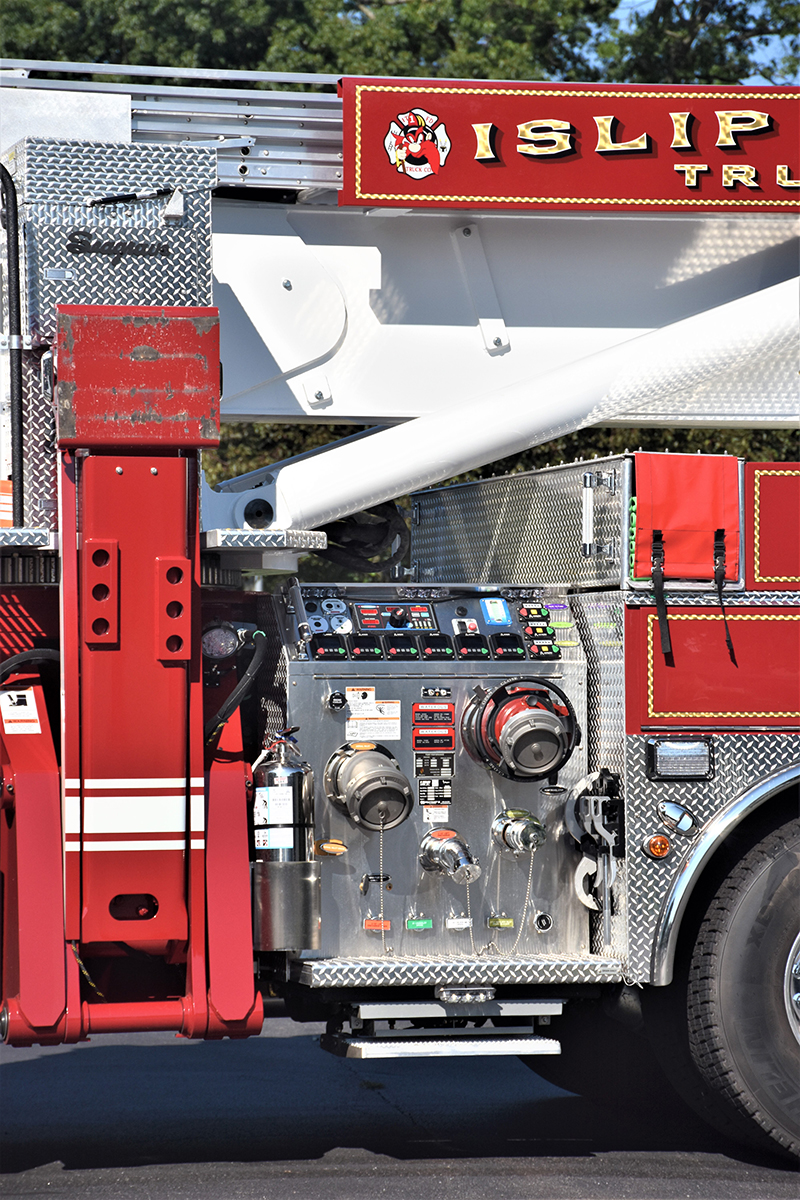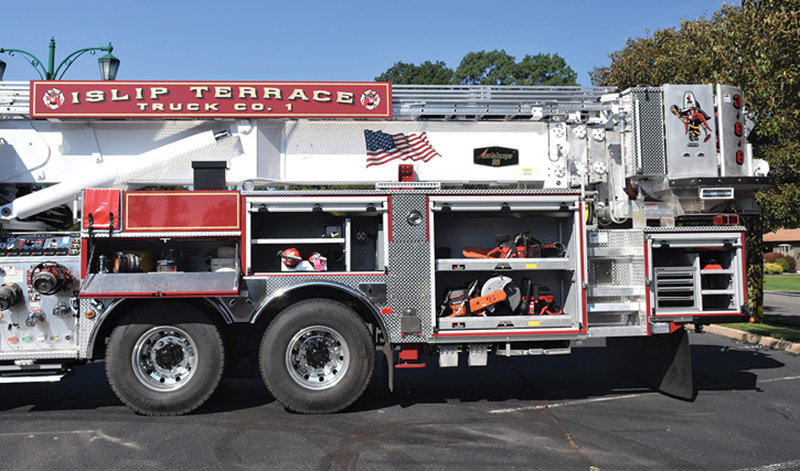
The Islip Terrace (NY) Fire Department, located on Long Island’s south shore, was in the market for a new aerial platform. According to Chief (Ret.) and current District Manager Frank Cuoco, “Our current 70-foot 1995 Sutphen tower was 28 years old, and we felt it was time to replace it.

The current vehicle served us well. It had a single rear axle and was really compact, but we wanted something with a greater reach and more compartment space as well.”
According to Cuoco, the department started planning for the new truck in 2019. The apparatus committee comprised members from all the department’s companies, and some had a great deal of experience designing work vehicles for practical use. “In our case, the design was something that really mattered to us,” says Cuoco. “Our committee took into consideration our response district. While we are primarily a residential community, we also have several schools, places of worship, and strip shopping centers.”
The department had purchased two pumpers and a heavy rescue from Seagrave, and although committee members had to go out to bid for the new aerial, they hoped to standardize with Seagrave since they liked the product and would also allow commonality as far as the cab, its operation, and training for the members. “The fire district had funds available from our apparatus capital reserve fund to pay for the new truck,” adds Cuoco. “We were lucky Seagrave won the bid, meeting all of our specs and providing us with a stainless steel cab and body.” Cuoco says the 95-foot boom gave the department more side reach, which it was looking for. And, the rig was designed as a quint. “Our older truck was also a quint, so our members were used to that type of operation responding to fires,” he says.
Seagrave 95-Foot Aerialscope Quint
|
Cuoco explains that the new vehicle sets up quickly, as far as outriggers, and has single joystick operation for the boom. “This vehicle is somewhat longer than our older, single-axle truck and takes a little bit more training maneuvering it around town,” he says. “However, our members are up to the task. The extra compartment space is also great. We are able to carry all of our older tools plus newer tools as well.” The department upgraded to battery-powered Milwaukee hand tools, Sawzall, fans, and saws.”
The truck features a 2,000-gallon-per-minute pump (gpm), 300-gallon polypropylene tank, 500 feet of 5-inch large-diameter hose, and two 200-foot lengths of 1¾-inch hose. The extra compartment space it gained with the new rig will be used for future tool purchases.
“Our committee had the opportunity to travel to Clintonville, Wisconsin, to the Seagrave factory for an inspection visit,” says Cuoco. “As in the past, we were impressed with their operation and no changes had to be made to the truck while it was being built. The Seagrave engineers were receptive to all of our ideas and questions.” He adds that the local Seagrave dealer, RVI, is located a few miles from the department’s headquarters, which is convenient for maintenance and service. The department worked with RVI for the two pumpers and heavy rescue and has been happy with service after the sale for the three units.

1 The Islip Terrace 2023 Seagrave 95-foot Aerialscope has a 2,000-gpm pump and carries 300 gallons of water. (Photos by author.)

2 Shown are the officer’s side compartments with forcible entry tools and battery-powered hand tools.

3 The quint has a narrow pump panel with crosslays carrying 1¾-inch hose.
When you start the design and spec writing phase of any major fire apparatus build, you have to take into consideration what works well for your response district. Size and maneuverability are two of the major concerns, especially if you are designing an aerial device. If possible, see if the dealer has a demo available that your members can operate around town or, if a neighboring fire department has a similar truck, you may be able to operate it around your response district.
Islip Terrace (NY) Fire DepartmentThe department has two stations that house four pumpers, one truck, one heavy rescue, one Army 6×6 brush truck, and one ambulance. |

4 The driver’s side with compartments for saws, small hand tools, extinguishers, nozzles, and fittings.
Compartment space should be a major concern as well. Don’t just design compartments for your current equipment and tools. Plan for the future. Finally, look at the annex section of National Fire Protection Association (NFPA) 1901, Standard for Automotive Fire Apparatus, (soon to be updated to NFPA 1900, Standard for Aircraft Rescue and Firefighting Vehicles, Automotive Fire Apparatus, Wildland Fire Apparatus, and Automotive Ambulances) for the types of tools that you will carry and see what the weights will be. You don’t want to overtax the chassis and axles with an overweight truck. Your local dealer and factory engineers should be able to help out in this department.
One final consideration is to make sure you measure and remeasure the height of the vehicle and the height of the bay doors in your fire stations. There have been many horror stories of fire departments around the country having a truck built and, when delivered, it does not fit in the firehouse.
In all cases, if you properly plan for this major purchase and ask questions along the way, you shouldn’t have any problems. The Islip Terrace Fire Department was proactive in its design and planning and will have an excellent piece of apparatus that it will have in operation well into the future.
BOB VACCARO has more than 40 years of fire service experience. He is a former chief of the Deer Park (NY) Fire Department. Vaccaro has also worked for the Insurance Services Office, the New York Fire Patrol, and several major commercial insurance companies as a senior loss-control consultant. He is a life member of the IAFC.

